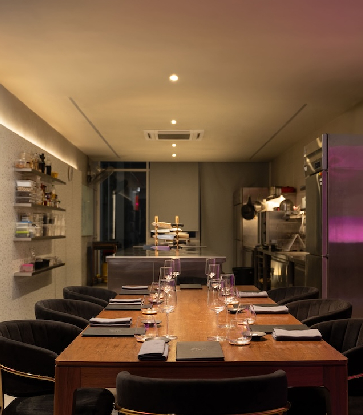Pattani-Thai food is the result of many influences: Southern Thai from the Andaman Sea blended with Javanese, Sumatran, Chinese and Malay flavours, mixed with the spices and recipes brought by Indian and Persian traders. A shared history means that many Pattani-Thai dishes can be found across the border in Malaysia, particularly in the nearby state of Kelantan that until the 19th century often found itself allied with the Thai king.

Ramkhamhaeng Road may be a bit off the beaten track but locals living in the eastern suburbs of the capital flock to it every evening to enjoy these unique dishes. The area is home to Ramkhamhaeng University and populated by a mix of students of the South, who have brought the flavors from their home to the capital, and young professionals. Throughout the year, they come at night to buy food at Ramkhamhaeng University Night Market which offers a variety of familiar street foods, like fried snacks and papaya salads made to order as well as southern delicacies. But during the month of Ramadan (this year from May 16 to June 14), the busy market bursts with Muslims breaking their traditional fast at sunset with traditional foods of the south and non-Muslims who come to share the festive treats.

Many people will stick to the brightly lit market area south of Ramkhamhaeng Road and the streets surrounding Rajamangala Stadium, where soups and grilled dishes are served on mats on low tables that line the sidewalk. Diners can choose between the alcohol free halal tables or tables where cold beers can be ordered. But those who cross Ramkhamhaeng Road will find the unique flavors of Thailand's Deep South.

Roaming the Ramkhamhaeng Market to the north of the main road from soi 37 to soi 65, diners will find over 100 restaurants and stalls serving typically Deep South dishes such as gai golek, a chicken marinated in a vivid orange sauce, a mix of coconut milk, curry, lemongrass, tamarind and chili, that gives the dish a rich, sweet and sour flavor. At the market, only one shop called simply Gai Golek, owned by Kittikann, a native of Krabi, serves the specialty: “My recipe was taken actually from what I have been tasting when visiting Kelantan. I adapted it to suit Thai taste,” he says, meaning upping the level of spice and adjusting the sweetness.



Several stalls in both markets offer khao yam, a mixed rice salad with herbs. The rice is tinted blue with butterfly pea flowers, mixed with herbs including betal nut leaves, pak paew (more commonly known as laksa leaves or Vietnamese mint abroad), and a host of other ingredients added to order. The rice is mixed with the herbs and sprinkled with generous portions of toasted coconut, dried shrimp and chili flakes and topped with a tangy pudu (southern fish sauce) dressing.

At the corner of Ramkhamhaeng soi 59, a food court at 59 Mini Mall is easy to distinguish with its yellow roof. At the shop called Khrua Pak Tai, meaning the Southern Thai kitchen, all dishes are served by two young ladies, one from Pattani and her colleague from Narathiwat. They sell gai satay (chicken satay skewers) accompanied with rice cakes. Their specialties also include khao yam as well as khao man, a coconut-flavoured steamed rice, served with a crimson spicy sauce. “For fish or squid, they grind a sauce made of birds eye chili, onion, garlic, tamarind and turmeric,” says a smiling Suraya, a native of Narathiwat who comes often to the food court because “it tastes exactly like home”.

Next to Klu Khua Pad Thai shop is Ahmad working at Mix Pizza. Although his main activity is spinning pizzas for students, this young Pattani-born man is proud of his mixed cocktails of juice and sweet condensed milk and his “Teh tarik”. Originated from Malay – like many delicacies served in Pattani-Thai areas – this very popular tea made in Southern Thailand is made with sweet condensed milk that is dramatically poured from one vessel to another in a movement that is called “pulling” the tea and creates a foamy beverage.
Ramkhamhaeng soi 61 is home to a couple of Pattani-Thai restaurants that have been present for many decades. This is where you can get rice dishes accompanied by meat marinated in curry sauce with vegetables, known as khao gaeng. At Nasi Campur Muslim Pattani, the special of the house is a sour broth of beef bones and meat flavored with celery and onion scented with warm spices like cinnamon and star anise simply called soup nuea (beef soup) but definitely a cut above.

















